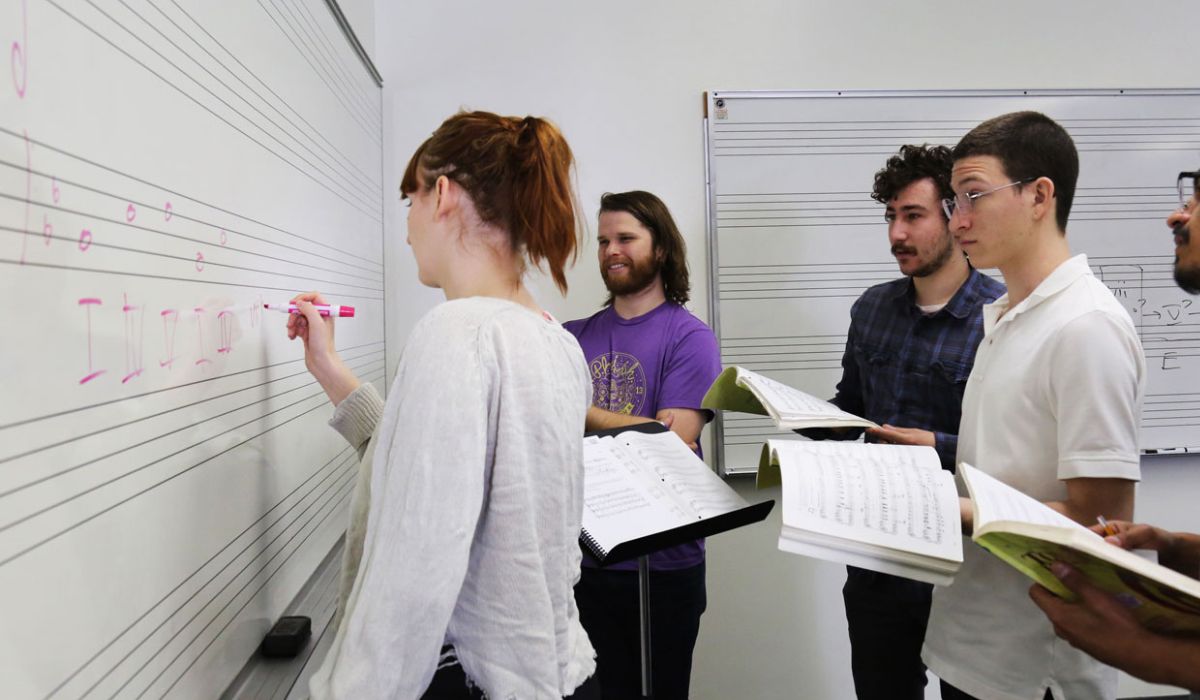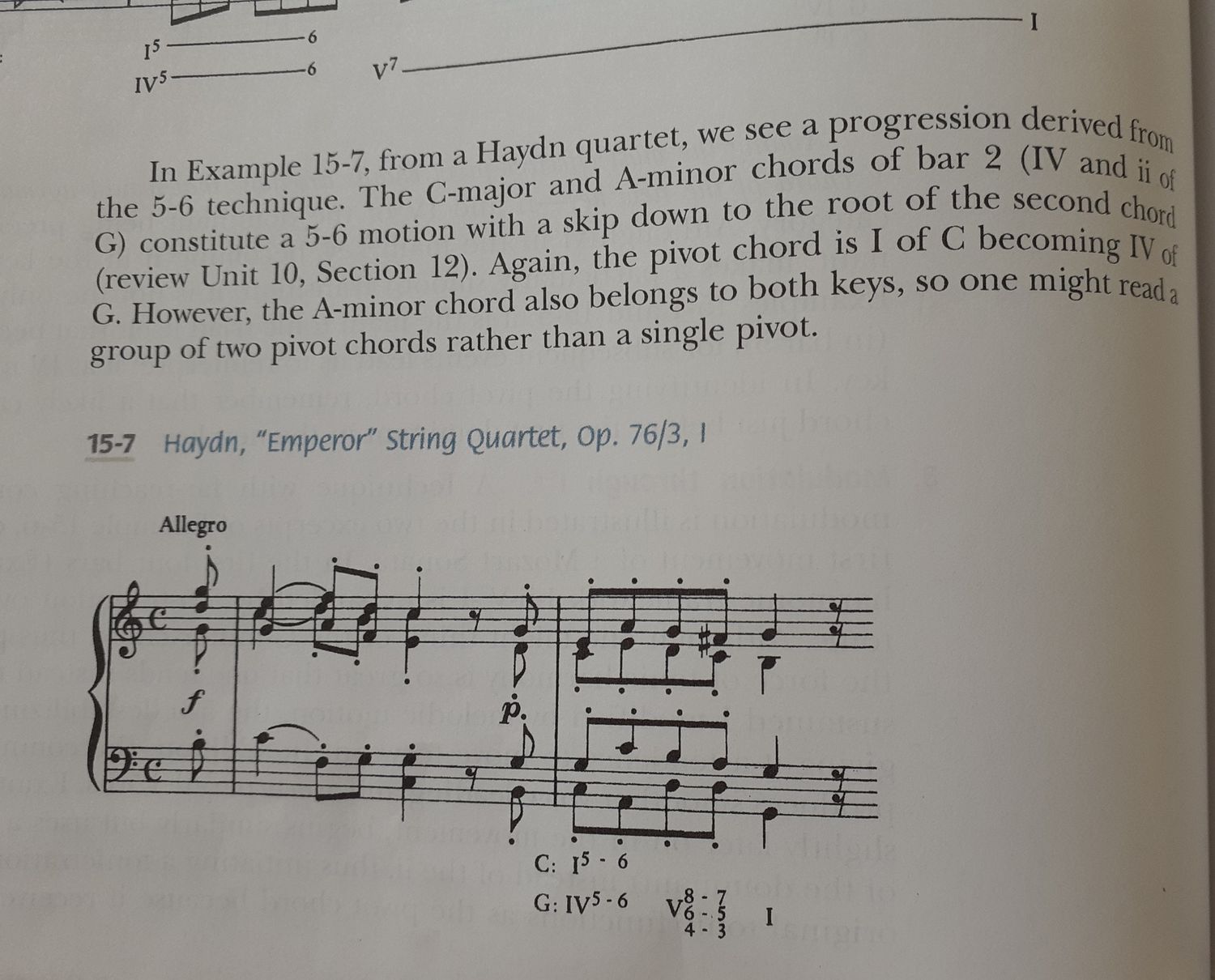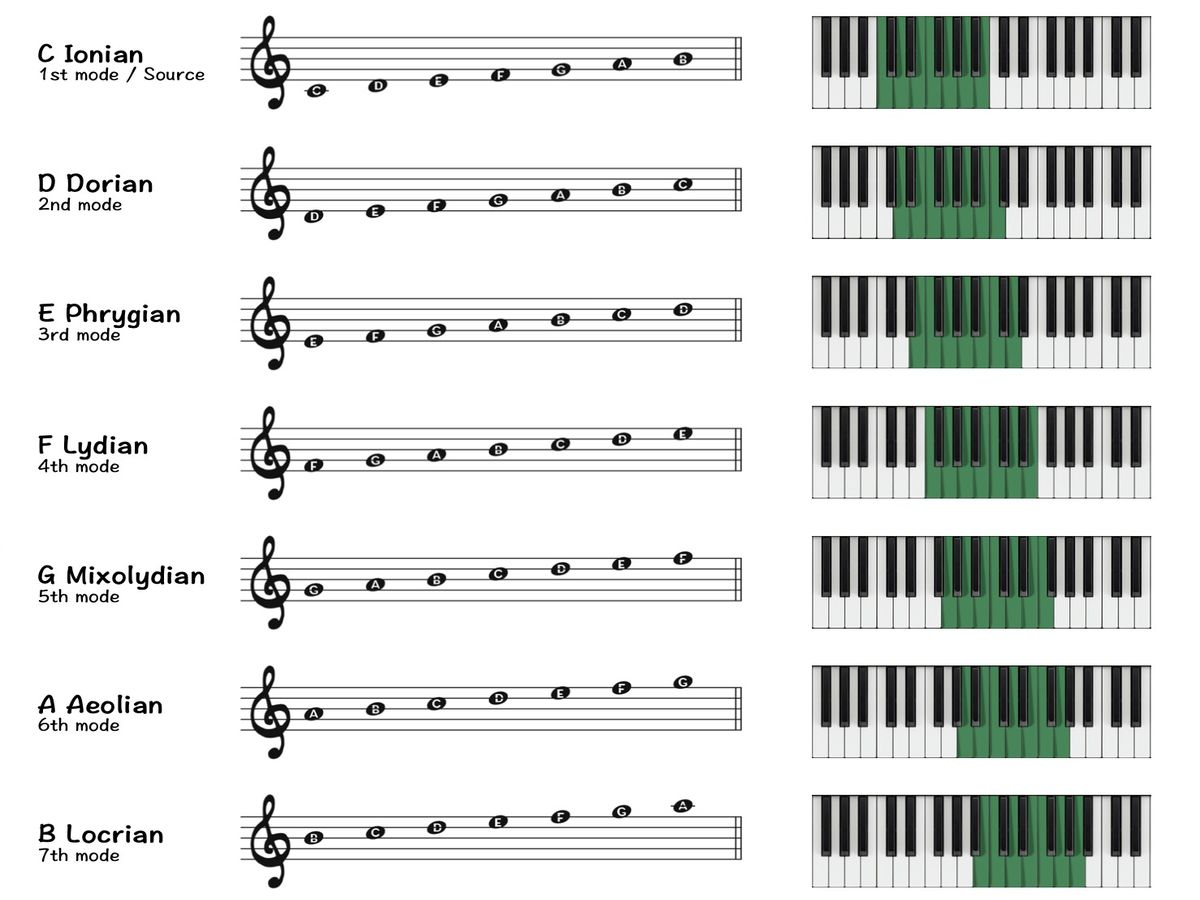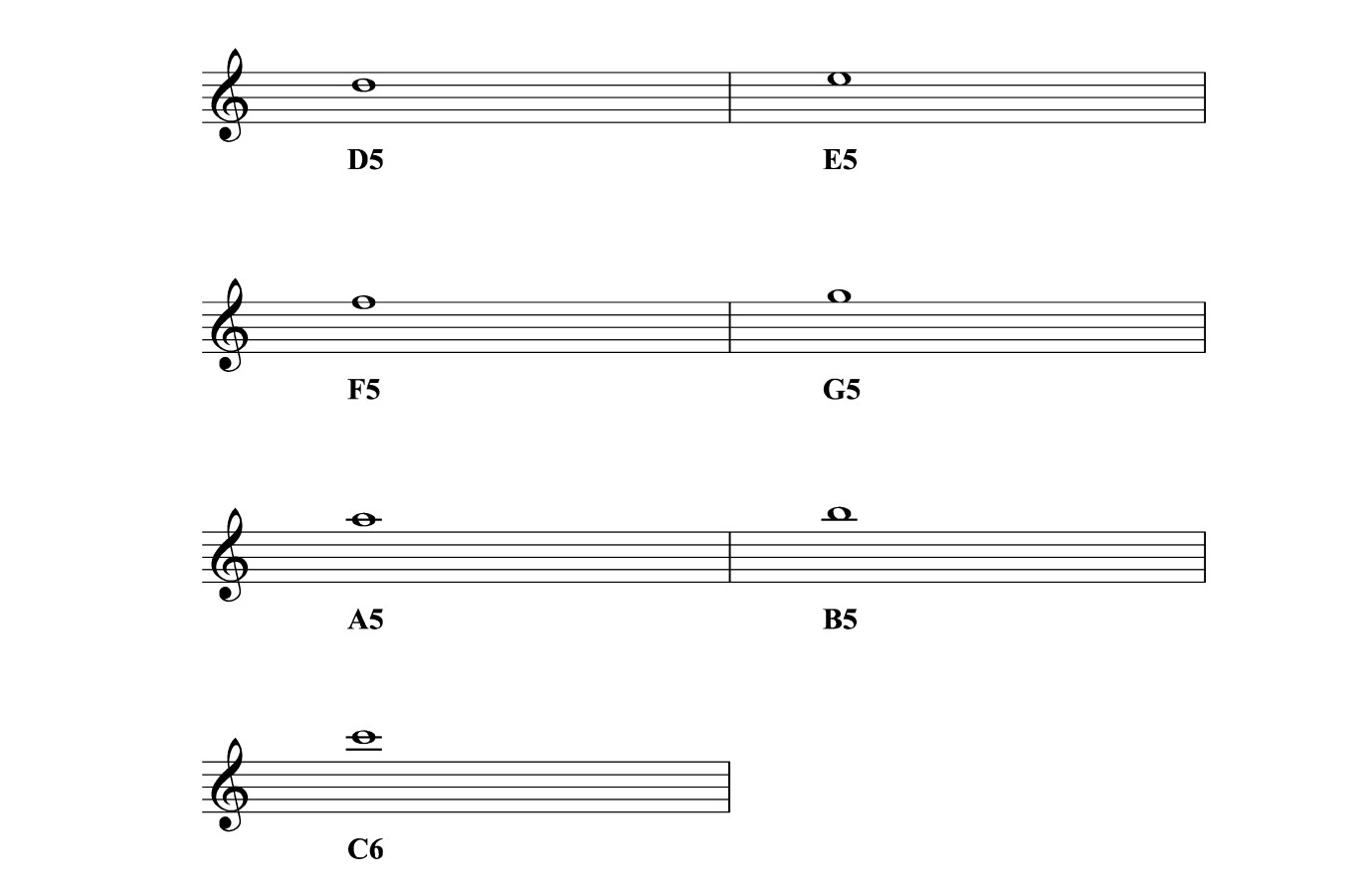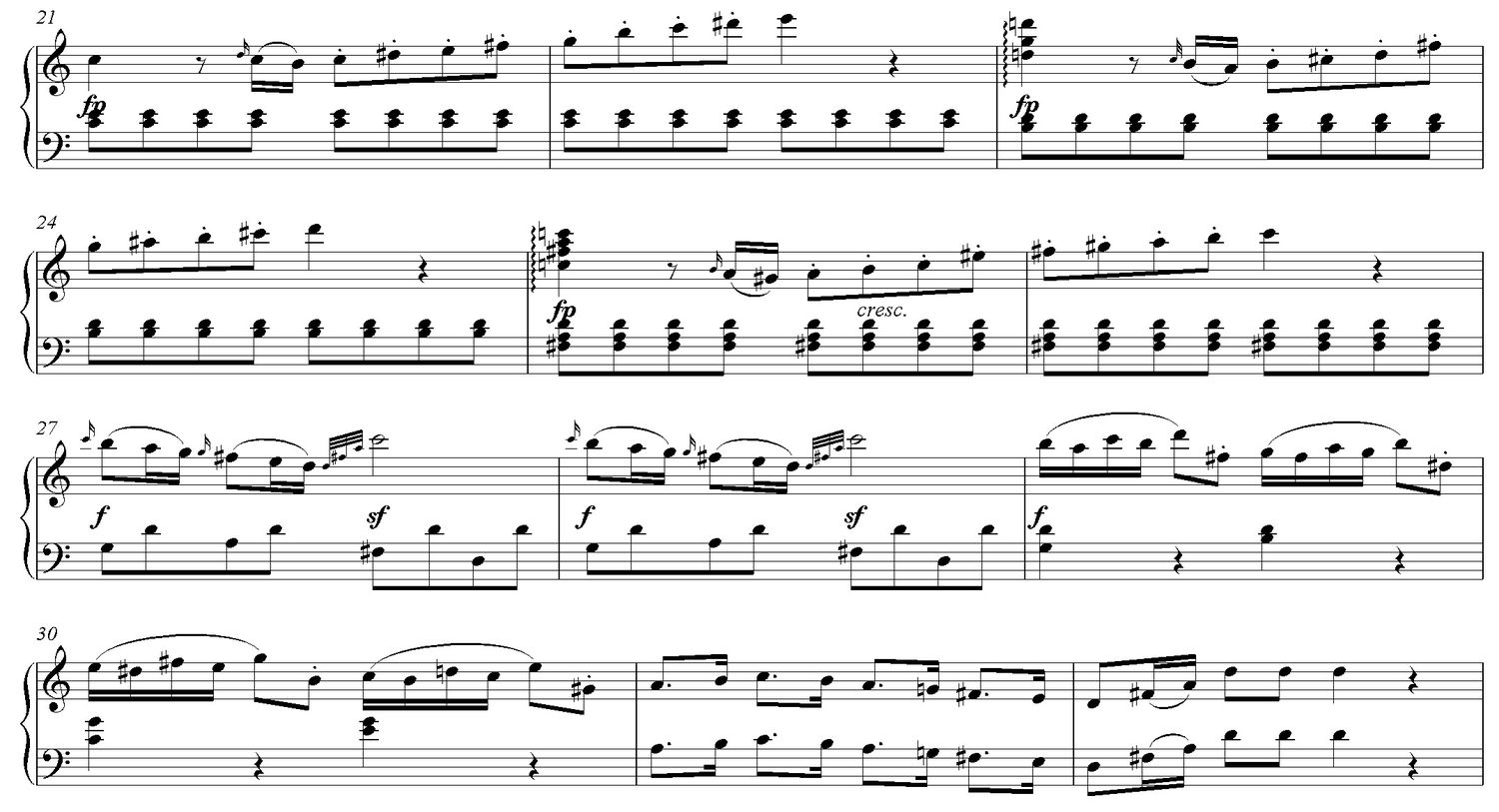Home>Production & Technology>Music Theory>How To Get A 5 AP Music Theory


Music Theory
How To Get A 5 AP Music Theory
Published: January 31, 2024
Learn the best strategies and resources for achieving a 5 in the AP Music Theory exam. Enhance your understanding of music theory and excel in your studies with these valuable tips and techniques.
(Many of the links in this article redirect to a specific reviewed product. Your purchase of these products through affiliate links helps to generate commission for AudioLover.com, at no extra cost. Learn more)
Table of Contents
- Introduction
- Understanding the AP Music Theory Exam
- Setting Goals and Creating a Study Plan
- Developing Strong Musical Foundations
- Music Theory Fundamentals
- Studying Melodic and Harmonic Analysis
- Mastering Aural Skills
- Practicing Sight Singing and Dictation
- Preparing for the Free Response Section
- Reviewing and Taking Practice Exams
- Test-Taking Strategies and Final Tips
- Conclusion
Introduction
Music theory is the backbone of understanding and appreciating music on a deeper level. It provides a framework for analyzing and interpreting various musical elements such as melody, harmony, rhythm, and form. For students who are passionate about music and want to take their musical knowledge to the next level, the Advanced Placement (AP) Music Theory exam is an excellent opportunity.
The AP Music Theory exam is designed to assess a student’s understanding and application of theoretical concepts in music. It covers a wide range of topics, including music notation, scales and key signatures, intervals, melodic and harmonic analysis, and aural skills. Achieving a high score on the AP Music Theory exam not only demonstrates a student’s proficiency in music theory, but it can also earn college credit and enhance their college applications.
In order to succeed on the AP Music Theory exam, it is crucial to have a solid understanding of music theory fundamentals, as well as strong analytical and listening skills. This comprehensive guide will provide you with the necessary strategies and study techniques to help you get a 5 on the AP Music Theory exam.
Throughout this guide, we will delve into various aspects of the exam, such as setting goals, creating a study plan, developing strong musical foundations, studying melodic and harmonic analysis, mastering aural skills, practicing sight singing and dictation, preparing for the free response section, reviewing and taking practice exams, and test-taking strategies.
By following the tips and techniques outlined in this guide, you will be well-equipped to tackle the AP Music Theory exam with confidence. Whether you are a high school student preparing for the exam or an adult looking to expand your musical horizons, this guide will provide you with the knowledge and tools to achieve success.
So, let’s dive in and embark on a journey to excel in AP Music Theory!
Understanding the AP Music Theory Exam
The AP Music Theory exam is a comprehensive assessment that evaluates a student’s knowledge and understanding of music theory concepts and skills. It consists of two main sections: multiple-choice and free response. The exam is designed to test a student’s ability to analyze and interpret music, as well as their aural skills.
The multiple-choice section of the exam includes questions that cover a wide range of topics, such as music notation, intervals, scales and key signatures, basic harmonic and melodic analysis, and music terminology. Students are required to demonstrate their knowledge by selecting the correct answers from a set of options.
The free response section of the exam allows students to showcase their analytical, listening, and compositional skills. In this section, students are presented with a series of musical excerpts and are required to analyze them by identifying key elements such as melodic and harmonic structures, cadences, and chord progressions. They are also asked to compose short musical passages based on given guidelines and parameters.
One important aspect of the AP Music Theory exam is the aural skills component. This involves the ability to listen to and identify various musical elements, such as intervals, scales, chords, and rhythmic patterns. Students are required to develop strong listening skills through practice and training, as this is an essential part of the exam.
Scoring on the AP Music Theory exam is based on a scale of 1 to 5, with 5 being the highest score. A score of 3 or higher is considered passing and may earn students college credit depending on the policies of individual colleges and universities. Achieving a high score not only demonstrates a strong understanding of music theory but can also enhance college applications and provide opportunities for advanced placement and exemptions from introductory music theory courses.
It is important to note that the AP Music Theory exam requires both theoretical knowledge and practical skills. Therefore, a comprehensive preparation strategy should include a balance of studying theoretical concepts, practicing analysis and composition, and developing aural skills through regular listening and training.
In the following sections, we will explore specific strategies and techniques for each component of the exam, providing you with a step-by-step approach to help you succeed on the AP Music Theory exam. Let’s dive deeper into the world of music theory and prepare ourselves for a rewarding and successful exam experience.
Setting Goals and Creating a Study Plan
Setting goals and creating a study plan is a crucial first step in preparing for the AP Music Theory exam. It allows you to organize your time effectively and focus on the specific areas that need improvement. Here are some tips to help you set goals and create a study plan that will maximize your chances of success.
1. Assess Your Current Level: Begin by evaluating your current knowledge and skills in music theory. Take a practice exam or review the topics and concepts covered in the AP Music Theory curriculum. This will give you a clear understanding of your strengths and weaknesses.
2. Set Realistic Goals: Set specific and attainable goals for yourself. Determine the score you wish to achieve on the exam and break it down into smaller milestones. For example, aim to master a certain number of topics or complete a certain number of practice questions each week.
3. Create a Study Schedule: Develop a realistic study schedule that fits your daily routine and allows for consistent and dedicated practice. Allocate specific time slots for different topics and activities, such as studying music theory fundamentals, practicing aural skills, and reviewing sample questions.
4. Prioritize Topics: Identify the topics that you find most challenging or that carry a higher weightage in the exam. Prioritize these topics in your study plan, dedicating more time and effort to mastering them. However, make sure to allocate sufficient time for all the other topics as well to maintain a well-rounded understanding of music theory.
5. Utilize Multiple Resources: Explore a variety of resources to enhance your understanding of music theory. Utilize textbooks, online courses, video tutorials, and practice exams to gain different perspectives and reinforce your knowledge.
6. Practice Regularly: Consistent practice is key to success in music theory. Set aside time each day to engage in active learning, such as analyzing musical excerpts, completing practice questions, and composing short musical passages. The more you actively engage with the material, the better you will grasp the concepts and retain the information.
7. Seek Feedback: Find a mentor, teacher, or study partner who can provide feedback and guidance throughout your preparation. Share your compositions, analysis, and practice recordings with them to receive constructive criticism and suggestions for improvement.
8. Stay Motivated: Remember why you have chosen to pursue the AP Music Theory exam and keep that motivation alive. Celebrate your achievements along the way, whether it’s completing a challenging topic or achieving a milestone in your study plan. Surround yourself with supportive peers and engage with the music community to stay inspired throughout your preparation.
Creating a study plan that aligns with your goals and encompasses a holistic approach to music theory will set a strong foundation for your success on the AP Music Theory exam. Stay disciplined, be consistent, and always strive for improvement. With dedication and perseverance, you can achieve your desired score and excel in your understanding and application of music theory.
Developing Strong Musical Foundations
Developing strong musical foundations is essential for success in the AP Music Theory exam. It lays the groundwork for understanding the fundamentals of music theory and provides a solid basis for further study. Here are some key areas to focus on when building your musical foundations:
1. Ear Training: Ear training is a crucial skill for any musician. Training your ears to recognize intervals, chords, and melodies will greatly enhance your ability to analyze and understand music. Practice identifying intervals by listening to different musical examples and associating them with familiar tunes or visual cues.
2. Sight Reading: Sight reading is the ability to read and interpret sheet music in real time. It is an important skill for the AP Music Theory exam, as you will encounter various musical passages that require immediate comprehension. Practice sight reading regularly to improve your fluency and accuracy in reading music notation.
3. Music Notation: Familiarize yourself with the elements of music notation, including note values, key signatures, time signatures, and dynamics. Practice writing out music examples and transcribing melodies and rhythms from recordings. This will help solidify your understanding of how music is represented on paper.
4. Rhythmic Accuracy: Develop your sense of rhythm and timing by practicing rhythmic exercises and studying different rhythmic patterns. Focus on accurately performing and counting rhythms, as this skill will be important when analyzing and composing music.
5. Keyboard Skills: Learning to play the piano or another keyboard instrument can greatly enhance your understanding of music theory. The keyboard provides a visual and tactile representation of music theory concepts, making it easier to grasp intervals, chord structures, and harmonic progressions. Consider dedicating some time to learning basic keyboard skills, even if you are primarily a vocalist or play a different instrument.
6. Music Listening: Actively listen to a wide variety of musical genres and styles. Pay attention to the musical elements such as melody, harmony, rhythm, and form. Develop your ability to recognize different musical styles and genres by studying the characteristics of each one. This will help you analyze and contextualize musical excerpts during the exam.
7. Music Theory Foundations: Study the basic principles of music theory, including scales, key signatures, intervals, chords, and harmonic progressions. Ensure you have a solid understanding of these concepts, as they form the building blocks for more advanced musical analysis.
By focusing on developing these strong musical foundations, you will gain a deeper understanding of music theory and build the necessary skills to excel in the AP Music Theory exam. Regular practice, consistent listening, and a commitment to musical growth will help you establish a solid musical foundation and pave the way for success in your musical journey.
Music Theory Fundamentals
To succeed in the AP Music Theory exam, a strong understanding of music theory fundamentals is essential. These fundamentals serve as the building blocks upon which more advanced concepts are built. Here are some key music theory fundamentals to focus on during your preparation:
1. Scales and Key Signatures: Familiarize yourself with different scales, including major, minor (natural, harmonic, and melodic), and modes. Understand how key signatures are related to scales and have a firm grasp on identifying key signatures and their corresponding scales.
2. Intervals: Intervals are the distance between two notes. Learn to recognize intervals by sight and sound. Practice identifying and constructing major and minor intervals, as well as perfect and augmented intervals.
3. Chords: Study the different types of chords, such as triads (major, minor, augmented, and diminished) and seventh chords (major, dominant, minor, half-diminished, and fully diminished). Understand chord progressions and cadences, and be able to analyze and build chords in different musical contexts.
4. Notation: Master the basics of music notation, including note values, time signatures, key signatures, clefs, and dynamics. Practice writing out musical examples and transcribing melodies and rhythms accurately.
5. Melodic and Harmonic Analysis: Learn to analyze and identify melodic and harmonic elements in music. Study the structure and characteristics of melodies, including phrase structure, contour, and ornamentation. Develop the ability to analyze a harmonic progression by identifying the chords, their inversions, and their relationships to the underlying key.
6. Roman Numeral Analysis: Roman numeral analysis is a common method used in music theory to analyze chord progressions based on their relationship to a tonic key. Practice identifying and analyzing chord progressions using Roman numeral analysis.
7. Form and Structure: Study the various forms and structures commonly found in music, such as binary form, ternary form, rondo form, and sonata form. Learn to recognize and analyze these different musical forms and understand how they contribute to the overall structure of a piece.
8. Terms and Symbols: Familiarize yourself with music terminology and symbols. Understand common terms and symbols used in musical notation, performance instructions, and analysis. This will help you accurately interpret and communicate musical ideas.
By solidifying your understanding of these music theory fundamentals, you will be better equipped to analyze, interpret, and compose music. Regular practice, active listening, and applying these concepts to musical examples will strengthen your foundation in music theory and set you up for success in the AP Music Theory exam. Remember to continually review and reinforce these fundamentals as you progress in your studies.
Studying Melodic and Harmonic Analysis
Melodic and harmonic analysis is a crucial skill in music theory and a key component of the AP Music Theory exam. It involves studying and understanding the melodic and harmonic elements in a piece of music, identifying the relationships between notes and chords, and analyzing the overall structure and progression of the music.
When studying melodic analysis, focus on the following aspects:
1. Melodic Contour: Examine the shape and direction of the melody. Identify any repeated or contrasting patterns and note any significant intervals or leaps.
2. Phrasing and Form: Analyze how the melody is divided into phrases and how these phrases contribute to the overall form of the piece. Look for cadences, sequences, and any melodic motifs or themes that are developed throughout the music.
3. Ornamentation: Recognize and interpret any melodic ornaments, such as trills, turns, or grace notes. Understand how these ornaments add expression and embellishments to the melody.
When studying harmonic analysis, consider the following elements:
1. Chord Progressions: Identify the chords being used in the piece and analyze how they progress from one to another. Pay attention to the functional relationships between the chords, such as tonic, dominant, or subdominant roles.
2. Harmonic Rhythm: Observe the rate at which the chords change and how they relate to the underlying rhythm of the music. Notice any patterns or deviations in the harmonic rhythm.
3. Cadences: Identify cadences, which are chord progressions that provide a sense of resolution or closure. Different types of cadences, such as authentic, plagal, or half cadences, can indicate changes in tonal or structural elements.
4. Modulations: Analyze any modulations or key changes in the music. Identify the new key and analyze how it is established and resolved.
To effectively study melodic and harmonic analysis, practice analyzing musical examples from a variety of genres and time periods. Use Roman numeral analysis to identify the chords and their relationships within the given key. Pay attention to the harmonic function of each chord and any non-harmonic tones or dissonances that add tension and color to the music.
Listening actively to a wide range of music, including classical, jazz, and contemporary styles, will help develop your ear for melodic and harmonic analysis. Train your ear to recognize common melodic and harmonic patterns and progressions.
Take advantage of study resources such as textbooks, online courses, and music theory exercises that provide practice examples for melodic and harmonic analysis. Engage in active listening exercises where you transcribe melodies and harmonies from recordings.
By studying and practicing melodic and harmonic analysis, you will develop a deeper understanding of how music is constructed, along with the ability to analyze and interpret music with greater detail and insight. This skill will not only benefit you in the AP Music Theory exam but also in your overall appreciation and understanding of music.
Mastering Aural Skills
Aural skills, also known as ear training, are a vital component of music theory and an essential part of the AP Music Theory exam. Developing strong aural skills will enhance your ability to recognize and identify various musical elements, such as intervals, scales, chords, and rhythms, solely by listening.
Here are some strategies to help you master aural skills:
1. Interval Recognition: Practice identifying intervals by their sound and understanding how they relate to familiar songs or melodic patterns. Start with simple intervals, such as the perfect fourth or major sixth, and gradually progress to more challenging intervals.
2. Scale and Mode Recognition: Familiarize yourself with the sound and characteristics of different scales and modes. Practice listening to various examples and identify the tonality and mode being used.
3. Chord Identification: Train your ear to recognize different types of chords, including triads and seventh chords. Practice differentiating between major, minor, augmented, and diminished chords by their unique sound.
4. Rhythm Dictation: Develop your ability to accurately notate rhythms by listening to rhythmic patterns and transcribing them. Start with simple rhythms and gradually increase in difficulty, incorporating different note values and subdivisions.
5. Melodic Dictation: Transcribe melodies by listening to musical excerpts and accurately notating the pitches and rhythms. Focus on capturing the contour and phrasing of the melody.
6. Harmonic Dictation: Create aural exercises where you listen to chord progressions and try to identify the chords by their quality and function. Practice recognizing common progressions and their characteristic harmonic motion.
7. Singing and Solfege: Engage in vocal exercises that involve singing intervals, scales, and melodic patterns. Utilize solfege syllables such as do, re, mi to internalize the relationships between pitches.
8. Sight Singing: Improve your ability to read and sing music notation by practicing sight singing exercises. Start with simple melodies and gradually progress to more complex pieces that involve larger intervals and rhythmic challenges.
9. Aural Analysis: Listen to musical excerpts and analyze the harmonic and melodic elements within them. Identify the chords, their inversions, and any non-chord tones or dissonances present in the music.
Consistent practice is key to mastering aural skills. Set aside dedicated time for regular ear training exercises and incorporate them into your daily study routine. Use online resources, mobile apps, and practice exams specifically designed for aural skills development.
Additionally, actively listen to a wide range of music from different genres and styles. Analyze the musical elements as you listen, paying attention to the relationship between the melody, harmony, rhythm, and form.
Mastering aural skills will not only enhance your performance on the AP Music Theory exam but also improve your overall musicianship. Developing a keen ear for music will enable you to better understand and appreciate the intricacies of musical composition.
Practicing Sight Singing and Dictation
Sight singing and dictation are essential skills for any musician, and they play a significant role in the AP Music Theory exam. These skills involve the ability to read and perform music notation accurately and to transcribe musical excerpts solely by ear. Here are some strategies to help you practice and improve your sight singing and dictation skills:
1. Start with Simple Exercises: Begin practicing sight singing with simple melodies that involve step-wise motion and limited rhythmic complexity. Gradually increase the difficulty by introducing larger intervals and more intricate rhythms.
2. Develop Rhythmic Accuracy: Pay close attention to the rhythm of the music and practice clapping or counting the beats before attempting to sing the notes. Develop a strong sense of rhythm and maintain a steady tempo while sight singing.
3. Internalize Intervals: Practice identifying and singing intervals by associating them with familiar songs or mneumonics. This will help you develop a strong sense of interval recognition and improve your accuracy when sight singing.
4. Use Solfege: Incorporate solfege syllables, such as do, re, mi, into your sight singing practice. Assigning syllables to different pitches will help you internalize the relationships between notes and develop aural-kinesthetic connections.
5. Practice Transposition: Challenge yourself by sight singing and transposing melodies into different keys. This will not only improve your sight singing skills but also broaden your understanding of tonal relationships.
6. Engage in Regular Dictation Exercises: Practice dictation by listening to short musical excerpts and notating them accurately without the aid of an instrument or written music. Start with simple rhythms and melodies, then progress to more complex passages that include chords, non-chord tones, and varied rhythms.
7. Analyze and Evaluate: After completing a sight singing or dictation exercise, critically evaluate your performance. Check for accuracy in both pitch and rhythm, and identify areas where you may need to improve. Repeat the exercise multiple times to strengthen your skills.
8. Utilize Technology: Make use of online resources and mobile apps that provide sight singing and dictation exercises. These tools can offer instant feedback and provide a structured means of practicing.
9. Seek Feedback: Record your sight singing and dictation exercises and seek feedback from a teacher or mentor. They can identify areas of improvement and provide guidance to help you develop your skills more effectively.
Regular practice is crucial for developing and refining your sight singing and dictation abilities. Aim to include these exercises in your daily practice routine and gradually increase the complexity of the examples you work with. By consistently honing these skills, you will become more confident and proficient in reading and transcribing music, ultimately leading to success on the AP Music Theory exam.
Preparing for the Free Response Section
The free response section of the AP Music Theory exam requires students to demonstrate their analytical and compositional skills. To effectively prepare for this section, it is important to practice and familiarize yourself with the types of questions and tasks that may appear. Here are some strategies to help you prepare for the free response section:
1. Review Past Exam Questions: Familiarize yourself with the format and types of questions asked in the free response section by reviewing past exam questions. Identify common themes and patterns to better understand what to expect.
2. Analyze Musical Examples: Practice analyzing musical excerpts by identifying and labeling melodic and harmonic elements, chord progressions, cadences, and other structural characteristics. Pay attention to the musical context and how different elements contribute to the overall composition.
3. Compose Short Musical Passages: Develop your composition skills by regularly composing short musical passages. Practice writing melodies, harmonies, and chord progressions based on given guidelines or prompts. Experiment with different musical styles and forms to expand your creative range.
4. Utilize Music Notation Software: Familiarize yourself with music notation software and practice notating your compositions using digital tools. This will help you quickly and accurately notate your musical ideas during the exam.
5. Time Management: Develop a sense of timing and efficiency when completing free response tasks. Practice working within time constraints to ensure you can complete the required tasks within the allotted time.
6. Seek Feedback: Share your compositions and analysis with a mentor, teacher, or study partner, and seek their feedback. They can provide valuable insights and suggestions for improvement, helping you refine your skills and approach.
7. Develop Improvisation Skills: Practice improvisation to enhance your ability to compose on the spot. Experiment with different scales, chord progressions, and musical styles to expand your improvisational creativity.
8. Self-Evaluation: After completing free response practice exercises, evaluate your own work. Assess the clarity and accuracy of your analysis or composition, and identify areas that need improvement. This self-evaluation will help you identify strengths and weaknesses, guiding your study and practice sessions.
9. Refine Time Management Skills: During practice sessions, set a time limit for completing each free response task. Train yourself to manage your time effectively, allowing for both analysis and composition within the given timeframe.
By practicing and familiarizing yourself with the types of tasks that may appear in the free response section, you will build confidence and improve your performance. Regularly engage in analysis and composition exercises, seeking feedback and self-evaluating to refine your skills. With consistent practice and preparation, you will be well-prepared to tackle the free response section of the AP Music Theory exam.
Reviewing and Taking Practice Exams
Reviewing and taking practice exams is an essential part of preparing for the AP Music Theory exam. Practice exams not only familiarize you with the exam format and content but also allow you to assess your knowledge and identify areas for improvement. Here are some strategies to effectively review and take practice exams:
1. Obtain Official Practice Exams: Look for official AP Music Theory practice exams, which can be found on the College Board website or in review books specifically designed for the exam. These practice exams closely simulate the actual exam and provide the most accurate representation of the content and format.
2. Create a Realistic Testing Environment: When taking practice exams, simulate the actual exam conditions as closely as possible. Find a quiet space, set a timer, and eliminate distractions to create a focused and uninterrupted environment. This will help you gauge your performance under exam-like conditions and refine your time management skills.
3. Analyze Your Performance: After completing a practice exam, thoroughly review your answers and assess your performance. Identify areas where you excelled and areas where you struggled. This analysis will help you pinpoint specific topics or concepts that require further study and practice.
4. Review Incorrect Answers: Pay special attention to questions you answered incorrectly. Understand the correct answer and the reasoning behind it. Use this as an opportunity to revisit the corresponding topics and reinforce your knowledge in those areas.
5. Identify Common Patterns: Look for common patterns and themes in the questions that you missed or found challenging. This will help you identify any gaps in your understanding and focus your review on those specific areas.
6. Time Management: During practice exams, practice effective time management within the allocated time limits. Use a timer to ensure that you are able to complete all sections within the designated time frames. It is important to develop the ability to allocate your time appropriately for each question or task.
7. Track Your Progress: Keep a record of your practice exam scores and track your progress over time. Set specific goals for improvement and strive to increase your scores with each practice exam you take. This will help you stay motivated and monitor your overall progress.
8. Implement Feedback: If you have access to an instructor or mentor, share your practice exam results with them and seek their feedback. They can provide valuable insights, offer additional explanations, and suggest specific strategies to address your weaknesses.
9. Variety in Practice Exams: Increase the breadth of your preparation by using various sources of practice exams. This will expose you to different question styles, difficulty levels, and content areas. Seek out different resources, such as review books, online platforms, or study groups, to access a wide range of practice exams.
Regularly reviewing and taking practice exams is invaluable in your AP Music Theory exam preparation. It not only allows you to assess your knowledge and skills but also helps you become familiar with the exam format and build confidence. By identifying areas for improvement and focusing your study efforts accordingly, you will increase your chances of achieving success on the actual exam.
Test-Taking Strategies and Final Tips
As you approach the AP Music Theory exam, it’s crucial to develop effective test-taking strategies and implement final tips to optimize your performance. Here are some strategies and tips to help you excel on exam day:
1. Read the Instructions Carefully: Begin by carefully reading the instructions for each section of the exam. Understand the requirements and guidelines to ensure that your answers meet the specified criteria.
2. Manage Your Time: The AP Music Theory exam has time constraints for each section. Allocate your time wisely, answering the questions you are most confident about first to maximize your point potential. Leave ample time at the end to review your answers.
3. Pace Yourself: Remain aware of the time and pace yourself throughout the exam. Avoid spending too much time on a single question or section, as this can prevent you from completing all the tasks. If you’re unsure about a question, make your best guess and move on.
4. Show Your Work: When completing the free response or analysis sections, show your work and explain your thought process. Clearly illustrate your understanding of musical concepts and utilize proper music notation to support your answers.
5. Use Elimination Strategies: In multiple-choice questions, use the process of elimination to narrow down your options. Cross out unlikely or incorrect answers, increasing your chances of selecting the correct choice.
6. Pay Attention to Detail: In all sections of the exam, pay close attention to details such as key signatures, time signatures, accidentals, and symbols. Failure to notice these details can lead to errors in analysis or answering questions incorrectly.
7. Review and Double-Check: After completing each section, take a few minutes to review your answers. Look for any mistakes or omissions. It’s not uncommon to catch errors upon a second review, so use this time to ensure the accuracy of your responses.
8. Stay Calm and Focused: Maintain a calm and focused mindset throughout the exam. Avoid panic or rushing through questions. Take deep breaths and approach each task with confidence and a clear mind.
9. Practice Active Listening: During the aural sections, actively listen to the musical examples, focusing on key elements and patterns. Train your ear to identify intervals, chords, and rhythmic patterns accurately.
10. Trust Your Preparation: Have confidence in the effort you put into your preparation. Trust your knowledge and understanding of music theory principles. Believe in yourself and your ability to demonstrate your skills on the exam.
11. Get Adequate Rest: Prioritize getting sufficient rest the night before the exam. A well-rested mind will be better equipped to recall information and process questions during the exam.
12. Stay Hydrated and Eat Well: On exam day, ensure you’re hydrated and nourished. Proper hydration and nutrition can help maintain focus and sustain energy throughout the exam.
By implementing these test-taking strategies and following the final tips, you can approach the AP Music Theory exam with confidence and achieve success. Remember to stay calm, trust your preparation, and utilize your knowledge and skills to showcase your understanding of music theory. Good luck!
Conclusion
Congratulations! You have reached the end of this comprehensive guide on how to excel in the AP Music Theory exam. By implementing the strategies and techniques outlined here, you are well on your way to achieving a high score and demonstrating your understanding of music theory.
Throughout this guide, we discussed the importance of setting goals, creating a study plan, and developing a strong foundation in music theory. We explored various topics, including melodic and harmonic analysis, aural skills, sight singing and dictation, and preparation for the free response section. We also delved into reviewing and taking practice exams, as well as implementing effective test-taking strategies.
Remember that success on the AP Music Theory exam goes beyond simply memorizing facts and formulas. It requires a deep understanding of music theory principles, as well as the ability to apply that knowledge analytically and creatively. Engage in active listening, practice critical thinking, and foster a love for music as you embark on your journey towards excellence.
As you continue your preparation, don’t forget to take care of yourself physically and mentally. Get sufficient rest, eat well, and stay hydrated. Take breaks when needed, and find balance in your study routine. Maintaining a healthy and well-rounded approach to your preparation will contribute to your overall success in the exam.
Lastly, remember that the AP Music Theory exam is not the end goal but rather a stepping stone towards a deeper appreciation and understanding of music. Embrace the knowledge and skills you gain throughout this process and continue to explore new genres, styles, and composers.
We wish you the best of luck as you embark on this exciting journey towards achieving a 5 on the AP Music Theory exam. Trust in your abilities, stay focused, and enjoy the process of expanding your musical horizons. May the passion for music guide you to your well-deserved success!

